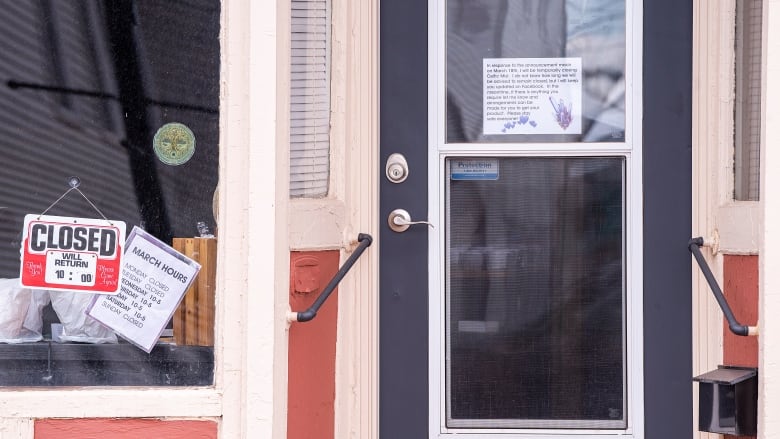P.E.I. drops 2,100 jobs in March, bigger losses expected to come
Number of people employed but not working spikes

The Labour Force Survey from Statistics Canada suggests P.E.I. was not yet feeling the biggest impact from the COVID-19 pandemic in mid-March.
The report shows a historically-excellent 8.6 per cent unemployment rate for March. That's up from 8.0 per cent in February, but an improvement over the 8.9 per cent from March of last year.
The survey was taken March 15-21, in the midst of the declaration of the public health emergency on the Island, and just as businesses were being shut down.
- March 16: Public health emergency declared.
- March 17: Restaurant dining rooms closed.
- March 18: Non-essential businesses asked to close.
"[The] impact seems much more modest than expected, but then the reference week starting on the 15th, was really only the starting point for the Island," said UPEI economist Jim Sentance.
"I expect to see a much bigger drop next month."
There are worrying signs when looking beyond the unemployment rate. The number of jobs, which had grown steadily since the beginning of 2019, was down significantly, as was the number of people in the labour force.
The number of jobs fell by 2,100, or 2.6 per cent. The unemployment rate remained relatively low because there were also significantly fewer people in the labour force. That was down 1.9 per cent.
Nationally the numbers were much worse with a million jobs lost, a drop of 5.2 per cent.
The P.E.I. government has estimated the pandemic could cost the economy 20,000 jobs by May, about 25 per cent of total employment.
Where the losses were
The timing of the survey makes reading it difficult. What losses were captured is dependent on when during the week people were surveyed.
The bulk of the losses came in two sectors that would be expected.
- Food service and accommodation: Down from 6,000 to 4,500.
- Information, culture and recreation: Down from 2,400 to 1,800.
But there is a big sector missing, wholesale and retail, which is P.E.I.'s largest employment sector. Jobs in wholesale at retail were largely static, dropping only slightly from 11,500 to 11,400. That suggests the pain of the closure of non-essential businesses is yet to be recorded.
Part-time workers were already feeling the pinch.
That number fell 1,000 to 11,200, an 8.2 per cent drop.
It is the only top-line statistic that is worse than March 2019, down 5.9 per cent from the previous year.
Economic shock
Officials with Statistics Canada have acknowledged that, while they say they're confident in the accuracy of the data from the Labour Force Survey for March, there are limitations in their methodology and its ability to represent a shock to the labour system on the scale of COVID-19.
They said some people counted as employed would have worked no hours during the period in question, while others had their hours reduced.
Sentance noted there was a 16 per cent decrease in the number of hours worked.
Meanwhile some who would otherwise have been counted as unemployed were instead counted as no longer being part of the labour force because they were not looking for work understandable during a period when many businesses are closed and potential workers are trying to self-isolate or maintain physical distancing.
New data
In an effort to make a little more sense of the dramatic changes in March, Statistics Canada included some data in the Labour Market Survey that it usually doesn't.
Among that data was people who were employed, but did not work in the previous week, as well as employed people who worked fewer than 50 per cent of their regular hours in the previous week.
The data is not seasonally adjusted, which is usual for reporting job changes, so it is possible to make comparisons from month to month.
But still it is clear these numbers spiked dramatically.
Employed but not working hovered between 600 and 1,200 in 2019, and leapt to 6,800 in March. Those working fewer hours was between 1,800 and 4,000 in 2019, and jumped to 7,700 last month.
Looking ahead
As the Island economy moves deeper into spring, UPEI economist George Jia expects seasonal and part-time jobs will bear the worst of the crisis.
The hospitality industry will be particularly hard hit, he said.
"The agriculture industry, on the other hand, should see improvement as demand increases (partially driven by panic buying) and the supply of imported food disturbed by the pandemic," Jia wrote in an email to CBC News.
Farmers do face a serious problem, however, with the availability of temporary foreign workers still up in the air, he said.
That shortage could lead to production difficulties, or could lead to a need to hire local labour at higher wages, which will hit farm profits.
Jia noted some businesses are already startingto adapt to operating with physical distancing rules in place. Restaurants are moving to delivery and curbside pickup, a distillery is producing hand sanitizer, but adapting for others, such accommodations, will be much more difficult.
More from CBC P.E.I.
With files from Kerry Campbell












_(720p).jpg)


 OFFICIAL HD MUSIC VIDEO.jpg)
.jpg)



























































































